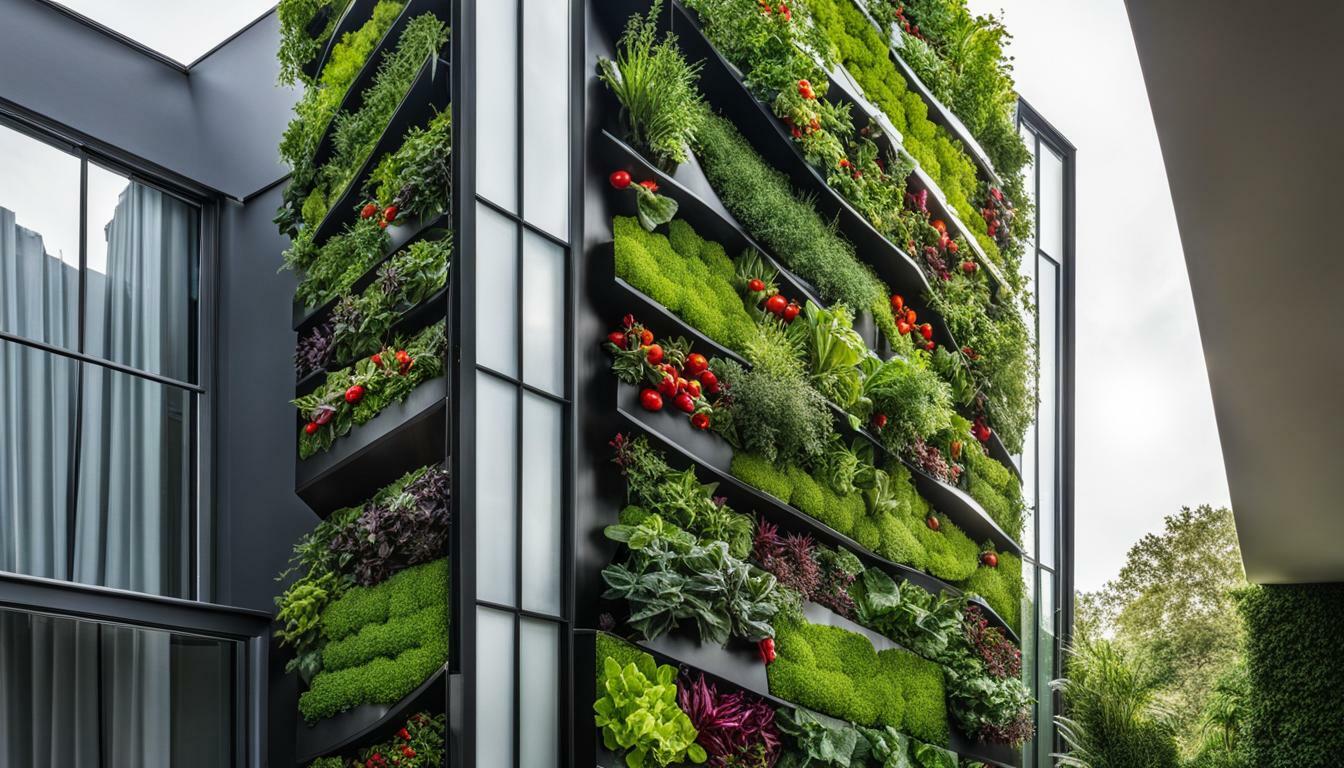Key Takeaways:
- Hydroponics vertical gardens allow for high-density yield per unit area, making them ideal for small spaces like balconies, patios, and rooftops.
- These gardens enable year-round production indoors, providing fresh produce regardless of the season.
- Vertical hydroponic systems optimize space utilization, maximizing the number of plants that can be grown in a limited area.
- By using nutrient-rich water that is fed from the top and collected at the bottom, vertical hydroponics can achieve over 90% efficiency in water use.
- With no soil-borne diseases, hydroponics vertical gardens offer a clean and healthy growing environment for plants.
Experience the Future of Gardening with a Hydroponics Vertical Garden
Step into the future of gardening by embracing the wonders of a hydroponics vertical garden. This innovative approach to gardening combines the benefits of hydroponics with the space-saving design of vertical farming, allowing you to grow a wide variety of plants in small indoor or outdoor spaces. Whether you have a small balcony, patio, or even a spare room, a hydroponics vertical garden can transform your home into a thriving oasis of greenery.
With vertical hydroponics, plants are grown in vertically stacked layers, utilizing the efficient use of space. By stacking multiple levels, you can maximize your yields and grow more produce in a fraction of the space required for traditional soil-based gardening. The controlled environment of a hydroponics vertical garden also allows for optimal growth rates, resulting in higher productivity and efficiency.
One of the key advantages of a hydroponics vertical garden is the absence of soil. Hydroponics systems provide plants with the necessary nutrients directly through the water, eliminating the need for soil and minimizing the growth of weeds or pests. This soilless growth not only reduces maintenance but also creates a clean and efficient gardening solution. Additionally, without the limitations of soil-borne diseases, you can enjoy the benefits of soil-free gardening and the peace of mind that comes with knowing your crops are healthy and safe.
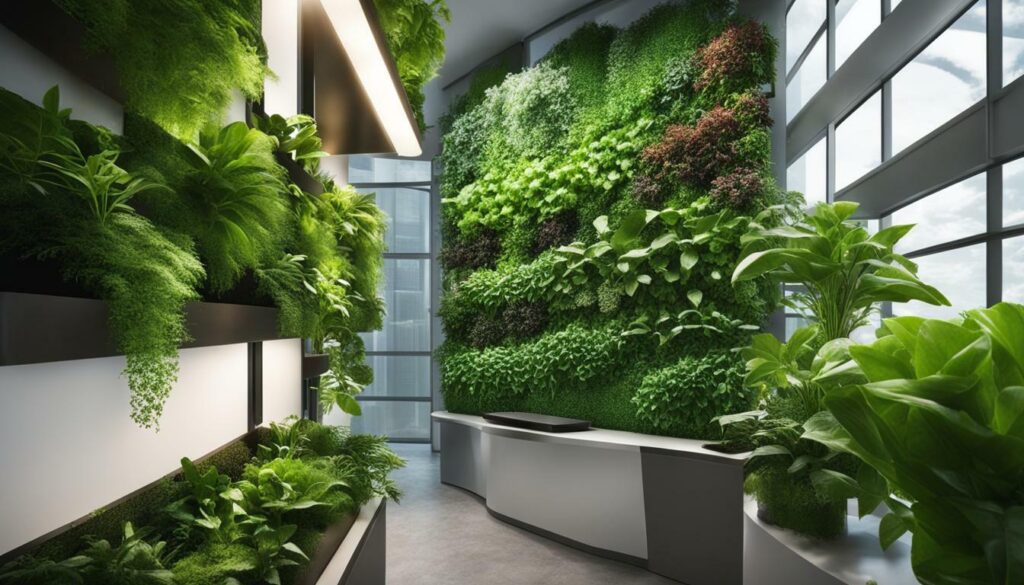
| Advantages | Description |
|---|---|
| Space Savings | A hydroponics vertical garden maximizes the use of limited space and is ideal for urban gardening. |
| Lack of Soil | Hydroponics eliminates the need for soil, reducing the risk of weeds, pests, and diseases. |
| Efficiency & Productivity | Vertical hydroponics allows for high yields and faster growth rates, resulting in increased productivity. |
| Low Maintenance | A closed-loop system in vertical hydroponics minimizes wastage and reduces the need for constant maintenance. |
While vertical hydroponics offers numerous advantages, it does come with its own set of challenges. Water flow can be a concern in a vertically stacked system, as ensuring equal water distribution to all plants requires careful design and appropriate pump power. Likewise, providing sufficient light to all levels of the garden can be challenging indoors, where natural sunlight may be limited. However, with the use of strategically positioned grow lights, you can overcome this obstacle and create an ultra-compact and high-yield hydroponic setup.
Despite these challenges, the future of gardening lies in the innovative concept of hydroponics vertical gardens. With their space-saving design, soil-free growth, and high efficiency, these gardens offer a sustainable solution for growing fresh produce in limited spaces. Whether you are a passionate gardener or simply want to bring the beauty of nature indoors, a hydroponics vertical garden is the perfect choice to enhance your home and experience the future of gardening.
Optimize Space with a Vertical Hydroponic System
Say goodbye to traditional gardening constraints and make the most of your available space with a vertical hydroponic system. Whether you have a small balcony, patio, or even just a corner in your home, vertical hydroponics offers a smart solution to maximize your gardening potential.
Vertical hydroponics utilizes innovative techniques that allow plants to be grown in a vertical, gravity-fed system without the need for soil. Instead, mineral nutrients are directly provided through water, resulting in efficient and compact garden designs.
With vertical hydroponics, you can optimize space utilization by growing crops in multiple stacked levels. This high-density yield per unit area is perfect for small sunny places like balconies, patios, and rooftops. It’s also a great option for indoor gardening, enabling year-round production of fresh herbs and vegetables right in your home. No longer limited by seasonal changes or weather conditions, you can enjoy a continuous supply of homegrown produce.
In addition to space savings, vertical hydroponics offers numerous other advantages. These systems are highly efficient in water usage, often achieving more than 90 percent efficiency. They also eliminate the risk of soil-borne diseases, providing a cleaner and healthier environment for your plants. Furthermore, vertical hydroponics allows for precise control over nutrient intake, resulting in increased yields and healthier crops.
| Advantages of Vertical Hydroponics: |
|---|
| Compact and space-saving design |
| No soil required |
| High efficiency and productivity |
| Minimal wastage and maintenance |
By embracing a vertical hydroponic system, you can transform any space into a thriving garden that adds greenery and freshness to your home. Whether you’re growing herbs, vegetables, or decorative plants, vertical hydroponics offers a sustainable and efficient solution for all your gardening needs.
Next, we’ll explore tower gardens in vertical hydroponics and how you can build your own.
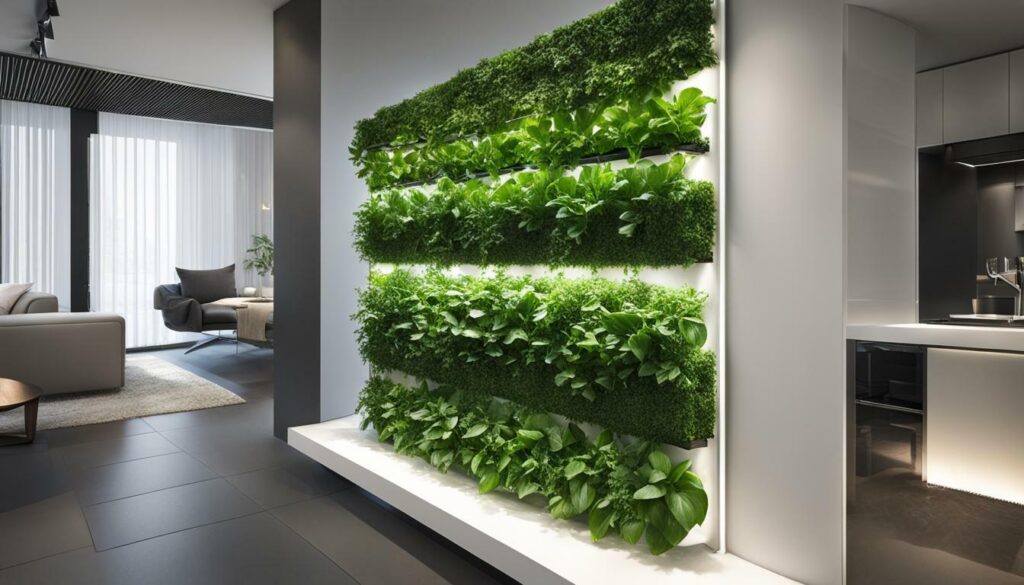
Boost Yields with a Hydroponics Vertical Garden
Increase your garden’s productivity and harvest bountiful yields with the help of a hydroponics vertical garden. By utilizing vertical hydroponic systems, you can optimize space, enhance efficiency, and unlock the full potential of your gardening endeavors.
The Advantages of Vertical Hydroponics
One of the main advantages of vertical hydroponics is its space-saving design. With limited floor space, vertical gardens provide the solution for maximizing cultivation in small indoor or outdoor areas. By growing plants vertically, you can achieve high-density yield per unit area and make efficient use of balconies, patios, rooftops, and other small sunny places.
Additionally, vertical hydroponics eliminates the need for soil, reducing the risk of soil-borne diseases and minimizing weed growth. Hydroponics offers a soilless method of growing plants, providing a cleaner and more practical approach to vertical gardening. It also allows for precise control of nutrient delivery, ensuring optimal growth and maximizing productivity.
Furthermore, vertical hydroponic systems promote efficiency and productivity. The controlled environment of these systems allows for better regulation of temperature, humidity, air composition, and lighting. With the right nutrient mix and proper lighting, plants can experience accelerated growth rates, resulting in higher yields. Vertical hydroponics enables year-round cultivation, providing fresh produce in all seasons and contributing to a sustainable food production system.
Lastly, vertical hydroponic gardens require minimal maintenance. The closed nutrient and water flow system in these systems reduces wastage and conserves water. With proper automation, the entire process can be streamlined, minimizing the need for constant monitoring and upkeep.
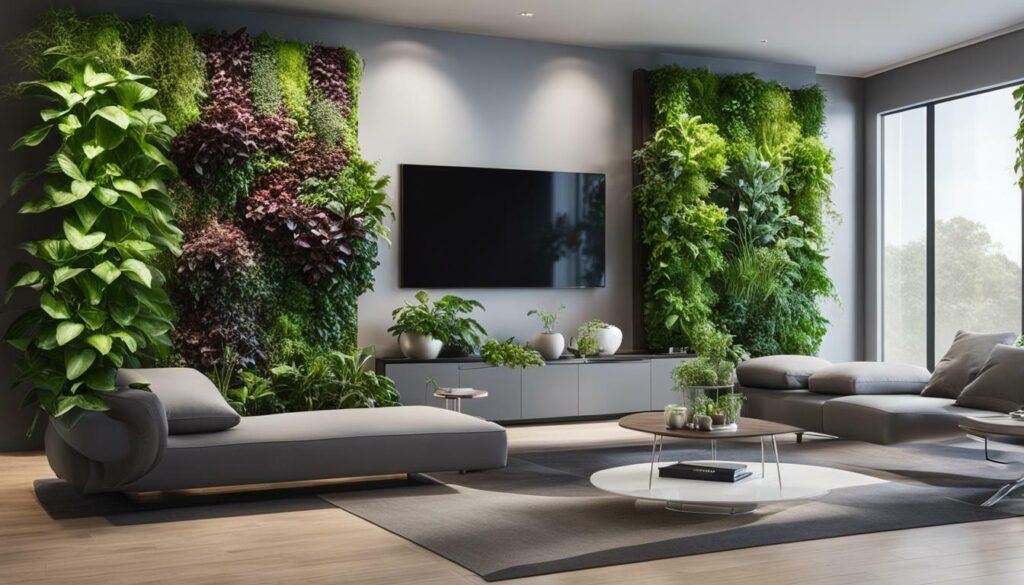
In summary, vertical hydroponics offers numerous advantages for boosting yields in your garden. Its space-saving design, soilless growth, efficiency, and low maintenance make it an ideal solution for modern gardening. Embrace the future of gardening and unlock the full potential of your home with a hydroponics vertical garden.
Add Greenery to Your Home with a Hydroponics Vertical Garden
Bring the beauty of nature into your home and enjoy fresh herbs and vegetables year-round with an indoor hydroponics vertical garden. This innovative gardening solution allows you to create a lush and vibrant green space in even the smallest of spaces. Whether you have a balcony, a patio, or just a tiny corner in your living room, a hydroponics vertical garden can transform your home into a peaceful oasis.
With an indoor vertical garden, you can grow a wide variety of herbs and vegetables right at your fingertips. Imagine plucking fresh basil leaves for a homemade pesto or harvesting crisp lettuce for a refreshing salad, all without stepping foot outside. Vertical hydroponic systems utilize nutrient-rich water to nourish plants, eliminating the need for soil. This soil-free method not only saves space but also reduces the risk of soil-borne diseases and eliminates the hassle of dealing with pests.
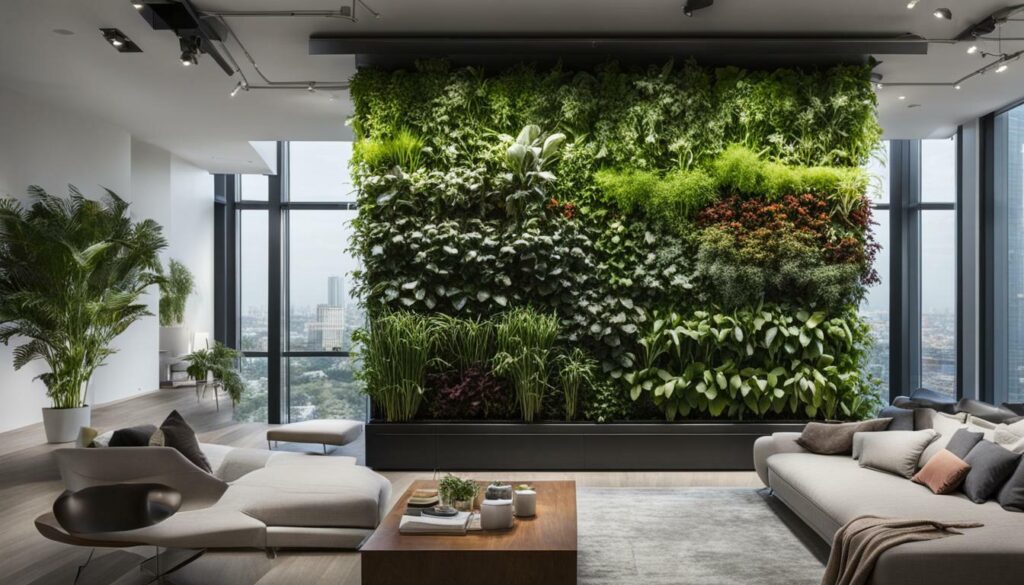
One of the major advantages of a hydroponics vertical garden is its efficiency in water use. With traditional gardening, a significant amount of water is often wasted through evaporation and runoff. In contrast, vertical hydroponic systems recirculate water, resulting in up to 80% water conservation compared to a standard garden bed. This makes it an eco-friendly choice for those who are conscious of their water usage.
In addition to its space-saving and water-saving features, a hydroponics vertical garden offers the convenience of year-round gardening. By providing optimal conditions for plant growth, such as controlled temperature, lighting, and air composition, you can enjoy a constant supply of fresh produce regardless of the season. Say goodbye to the limitations of traditional gardening and embrace the possibilities of an indoor hydroponics vertical garden.
Benefits of an Indoor Hydroponics Vertical Garden:
- Maximizes space utilization in small areas
- Eliminates the need for soil, reducing the risk of soil-borne diseases
- Conserves water through recirculation, resulting in up to 80% water conservation
- Allows for year-round gardening and a constant supply of fresh produce
Embrace the future of gardening and create your own indoor hydroponics vertical garden. With a variety of vertical hydroponic systems available in the market, you can easily find one that suits your space and gardening needs. Start growing your own herbs and vegetables today and enjoy the benefits of a lush, green oasis right in the comfort of your own home.
Understanding Tower Gardens for Vertical Hydroponics
Discover the wonders of tower gardens, the ultimate solution for creating a vertical hydroponic wall garden. With their innovative design and efficient use of space, tower gardens have revolutionized the way we grow plants indoors and outdoors. These vertical hydroponic systems offer an efficient and productive way to cultivate a wide variety of crops in limited areas.
Tower gardens utilize the concept of vertical farming, where plants are grown in stacked layers to optimize space utilization. By utilizing a gravity-fed system, tower gardens allow for the efficient delivery of nutrient-rich water to the plants. This vertical hydroponic system offers numerous advantages over traditional crop production methods. For starters, tower gardens allow for high-density yield per unit area, making them ideal for small sunny places such as balconies, patios, and rooftops.
Furthermore, tower gardens enable year-round production, making it possible to enjoy fresh produce regardless of the season. These vertical hydroponic systems also boast high water efficiency, often exceeding 90%, making them an environmentally-friendly choice. Additionally, tower gardens eliminate the risk of soil-borne diseases, ensuring healthier and more vibrant plants.
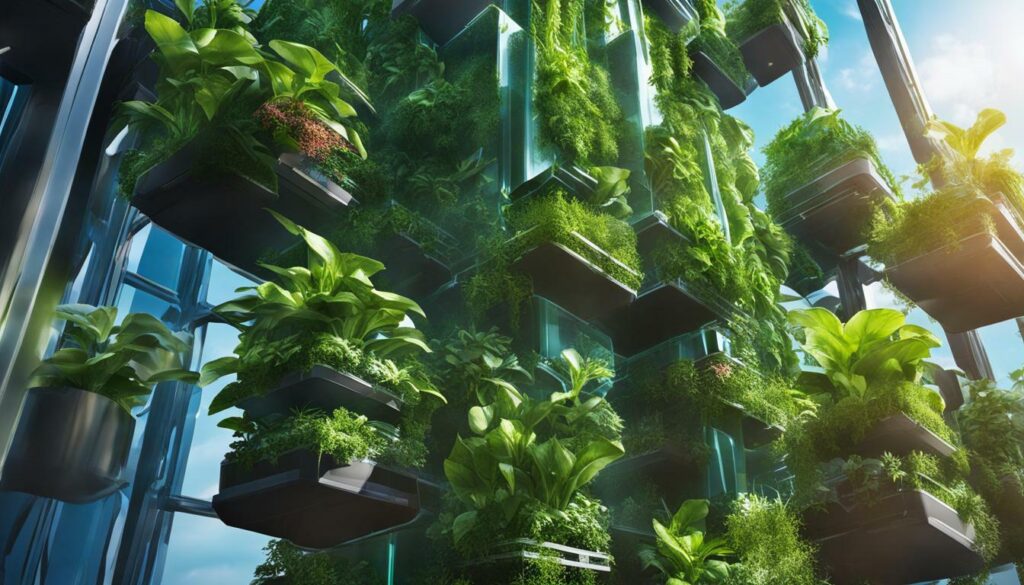
The design of a tower garden typically consists of a vertical tower made from materials such as PVC pipes or drainage pipes. The tower is equipped with net pots at regular intervals to accommodate the plants. Nutrient-rich water is constantly circulated through the tower, ensuring that each plant receives the necessary water and nutrients. Tower gardens can be customized to fit any space and can hold a significant number of plants, leading to increased yields.
Table: Materials Required for Building a Tower Garden
| Materials | Quantity |
|---|---|
| White vinyl fence post | 1 (5 inches x 5 inches x 8 feet) |
| White vinyl pyramid post tops | 2 |
| 45-gallon tank | 1 |
| Plastic sheet for preparing tank lid | 1 |
| 3-inch PVC pipe | 10 feet |
| Submersible pump (400 gallons per hour) | 1 |
| Light timer | 1 |
| Net pots | 28 (3 inches) |
| Silver 1-inch narrow utility hinge | 1 |
| Brass 1 ½-inch narrow utility hinges | 2 |
Building your own tower garden is a rewarding and cost-effective way to embrace vertical hydroponics. By following the step-by-step guide and using the required materials, you can create a thriving vertical garden in no time. Whether you have limited outdoor space or want to bring nature indoors, a tower garden offers a practical solution for growing a wide range of plants. Start your vertical hydroponic journey today and experience the joys of a tower garden.
Building Your Own Tower Garden
Take control of your gardening destiny by constructing your very own tower garden for your vertical hydroponic system. Building a tower garden is a rewarding and cost-effective way to grow a variety of plants in a limited space. With a few materials and some basic tools, you can create a vertical garden that will not only enhance the aesthetics of your home but also provide fresh and nutritious produce right at your fingertips.
To help you get started, here is a step-by-step guide on building your own tower garden:
- Start by gathering the necessary materials, including a white vinyl fence post, pyramid post tops, a 45-gallon tank, PVC pipe, a submersible pump, net pots, hinges, screws, and various other tools and accessories.
- Next, cut the white vinyl fence post to the desired height for your tower. Drill a hole in a plastic sheet that will serve as the lid for the tank and allow the fence post to pass through.
- Using a template, mark the locations for the net pot holes on the fence post and attach the pot hole template using adhesive. Cut out the pot holes using a jig saw.
- Prepare the net pot support by cutting a 3-inch PVC pipe at a 45-degree angle with a height of 2.25 inches. This will hold the net pots in place within the tower.
- Create a rectangular cut at the bottom of the tower to allow water to exit. Attach net pot holders throughout the length of the tower using PVC epoxy.
- Prepare the top of the tower by attaching pyramid post tops with drilled holes using hinges. Cover the screws with clear silicone for aquariums to prevent corrosion.
- Attach 4-inch pieces of white vinyl blind stop molding inside the tower to ensure proper distribution of the nutrient solution. Use PVC epoxy to secure them in place.
- Place net pots in the holes, marking the edges that touch the top of the hole. Melt these areas with a soldering iron to prevent water flow outside the tower.
- Create a small lid for the tank and attach it with a hinge. Drill a hole in the tank cover to pass a nutrient supply hose.
- Install a submersible pump in the reservoir and attach the nutrient supply hose. Use a T barb on the hose to supply nutrient solution to both towers.
Once your tower garden is complete, you can start planting a variety of crops, including strawberries, lettuce, herbs, and more. The vertical design allows for high-density yield per unit area, making it ideal for small sunny places like balconies, patios, and rooftops. With efficient water use and no soil-borne diseases, your tower garden will not only save space but also produce healthy and vibrant plants.
So why wait? Start building your own tower garden today and experience the benefits of vertical hydroponics firsthand.
Tower Garden Building Materials
| Materials | Quantity |
|---|---|
| White vinyl fence post (5″ x 5″ x 8 feet) | 1 |
| Pyramid post tops (white vinyl) | 2 |
| 45-gallon tank | 1 |
| Plastic sheet (for tank lid) | 1 |
| 3-inch PVC pipe (10 feet) | 1 |
| Submersible pump (400 gallons per hour) with attachments | 1 |
| Net pots (3-inch) | 28 |
| Hinges (1 silver 1-inch narrow utility hinge, 2 brass 1 ½-inch narrow utility hinges) | 3 |
| #6 32-inch x 3/8-inch machine screws with nuts | 8 |
| Clear silicone for aquariums | 1 |
| ½-inch nylon hose barb tee | 1 |
| Vinyl hose (10-foot length, inner diameter ½ inch, outer diameter ¾ inch) | 1 |
| 4-inch x 24-inch aluminum pipe for dryer vents | 1 |
| Medium grit sandpaper | 1 |
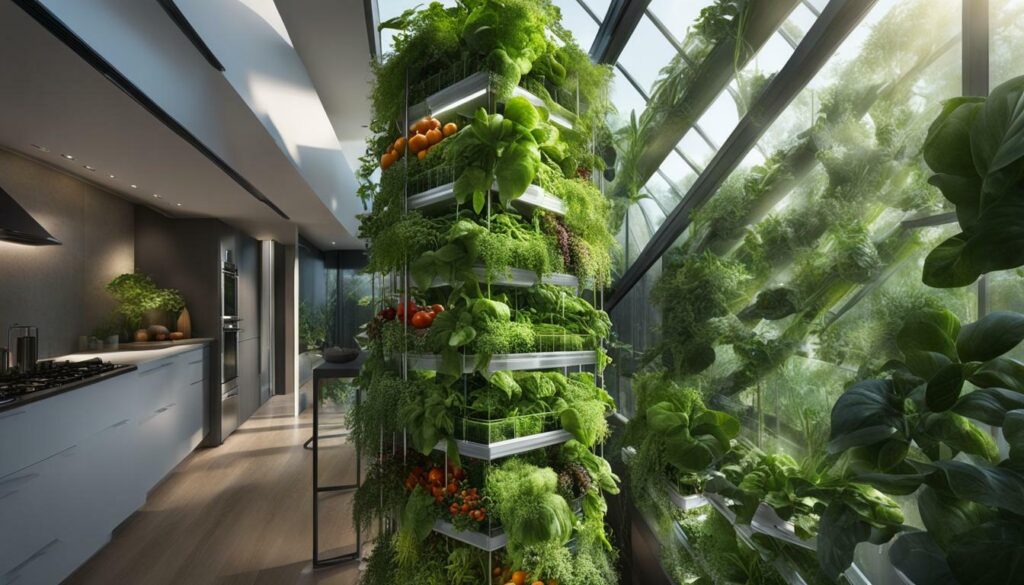
Advantages of Vertical Hydroponics
Unlock the potential of vertical hydroponics and enjoy the numerous benefits it offers, from saving space to achieving maximum efficiency. Vertical hydroponics is a game-changing gardening solution that allows you to optimize limited space and grow a wide variety of crops without the need for soil. Let’s explore the advantages of vertical hydroponics in more detail:
Space Savings
One of the biggest advantages of vertical hydroponics is its compact and space-saving design. By utilizing vertical space, you can grow more plants in small indoor or outdoor areas, making it ideal for urban farming. Vertical systems are perfect for fitting into corners, against patio walls, or even inside spare rooms, maximizing the usage of limited space. With the ability to grow crops closer together and eliminate the spread of roots, vertical hydroponics provides high-density yield per unit area.
Lack of Soil
Vertical hydroponics eliminates the need for soil, making it a lightweight and practical gardening solution. Without soil, you can minimize the growth of weeds, pests, and plant diseases, reducing the use of chemical fertilizers, fungicides, and pesticides. This soil-free environment promotes cleaner and healthier crops, while also making vertical hydroponics an ideal option for urban areas with limited access to arable land or in regions where climate change and destructive farming practices have led to soil erosion.
Efficiency & Productivity
Vertical hydroponics offers unparalleled efficiency and productivity compared to traditional gardening methods. With precise nutrient delivery directly to the roots, plants receive optimal nutrition, resulting in faster growth rates, higher yields, and better crop quality. By utilizing hydroponic techniques, such as the Nutrient Film Technique (NFT), plants can thrive in a gravity-fed system, where a thin stream of nutrient-rich water continuously flows over the roots. This controlled environment allows for year-round crop production and maximizes the potential of each plant, ensuring the most efficient use of resources and nutrients.
Low Maintenance
Vertical hydroponics systems are designed for low maintenance and sustainable operation. The closed-loop system ensures that water and nutrients stay within the system, minimizing wastage and providing a more eco-friendly approach to gardening. With proper design and automation, vertical hydroponics can conserve up to 80% of water compared to traditional soil-based systems. Reduced water consumption, minimal runoff, and fewer chemical inputs make vertical hydroponics a cost-effective and environmentally friendly choice for sustainable food production.
Unlock the potential of vertical hydroponics and experience the benefits of space-saving design, soil-free cultivation, increased efficiency, and low maintenance. Whether you’re an urban gardener or a commercial farmer, vertical hydroponics offers a sustainable and innovative solution for growing crops in a limited space.
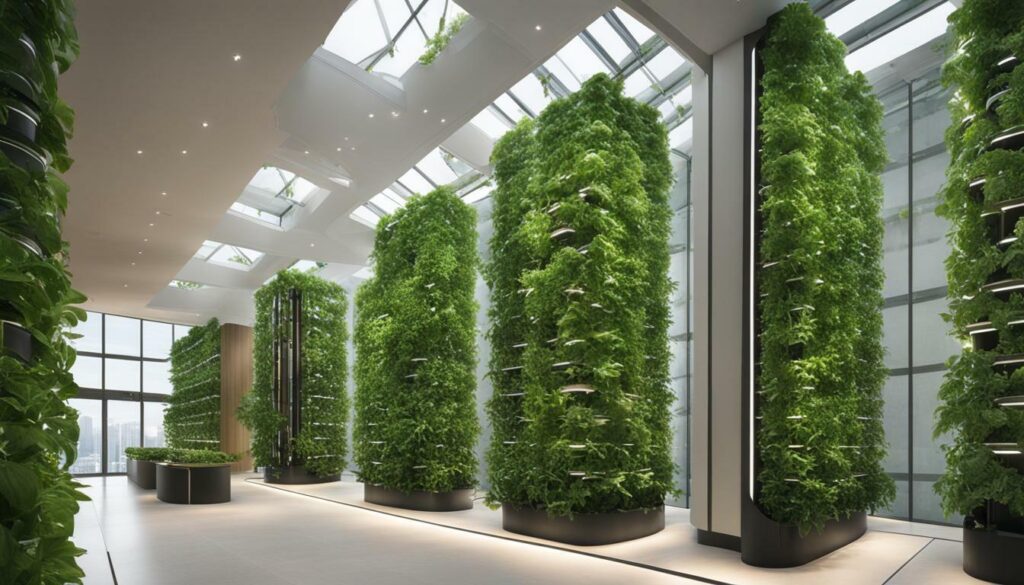
Overcoming Challenges in Vertical Hydroponics
While vertical hydroponics offers incredible advantages, it’s important to be aware of and address potential challenges in maintaining optimal water flow and lighting. These challenges can impact the overall success and productivity of your vertical hydroponic garden. By understanding and overcoming these challenges, you can ensure the long-term health and abundance of your plants.
Water Flow Challenges
One of the main challenges in a vertical hydroponics system is delivering sufficient water and nutrients to all plants, especially those in the upper levels. Due to the force of gravity, it may be necessary to use higher-powered pumps to ensure water reaches the top layers. If water is not properly distributed, lower plants may drown while upper plants may not receive enough water.
In order to overcome water flow challenges, it’s important to design your system carefully. Consider using multiple channels or tubes to deliver water to different levels for optimal distribution. Additionally, you may need to adjust the flow rate of your pump and ensure that water is evenly distributed across all plants. Regular monitoring and adjustment of water flow will help maintain a healthy growing environment for all plants in your vertical hydroponic garden.
Light Supply Issues
In an indoor vertical hydroponic system, providing adequate light to all plants can be challenging. Since plants are stacked on top of each other, it’s crucial to ensure equal light exposure for optimal growth. While outdoor systems can utilize staggered designs to maximize sunlight, indoor systems may require artificial grow lights.
To address light supply issues, consider using multiple vertically mounted lights to cover all levels of your vertical hydroponic garden. This will help distribute light evenly and ensure that all plants receive the necessary amount of light for photosynthesis. Invest in high-quality and energy-efficient grow lights that provide the appropriate spectrum for plant growth. Proper positioning of lights and regular monitoring will help you achieve optimal light conditions for your plants.
Resource Intensive
Vertical hydroponics can be resource-intensive, requiring energy for water pumps, grow lights, and constant monitoring. The increased number of plants in a vertical system means higher input costs for electricity and water. However, the long-term benefits of increased productivity and space saving outweigh the resource-intensive nature of vertical hydroponics.
To reduce costs and make your system more sustainable, consider using energy-efficient equipment and alternative energy sources such as solar power. Implementing a closed-loop system that recirculates water and nutrients can also minimize water consumption and nutrient wastage. Regular maintenance and monitoring of equipment will help optimize resource usage and ensure the long-term efficiency of your vertical hydroponic garden.
Overcoming challenges in vertical hydroponics requires careful planning, regular monitoring, and adaptation to your specific growing environment. By addressing water flow, lighting, and resource management, you can create a thriving vertical hydroponic garden that maximizes space utilization and yields high-quality, nutrient-rich produce.
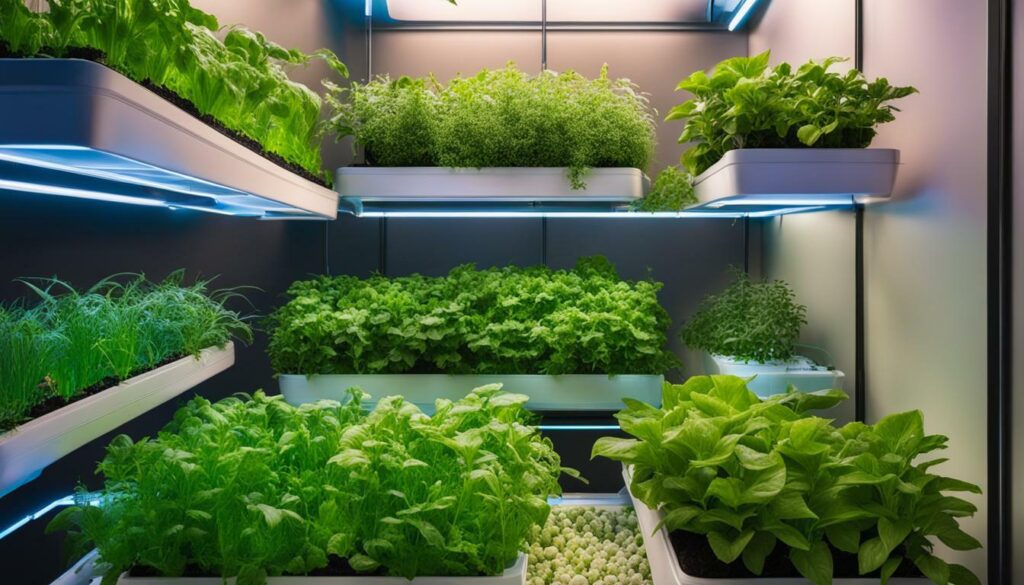
| Advantages of Vertical Hydroponics | Disadvantages of Vertical Hydroponics |
|---|---|
| – Space savings and efficient utilization of small indoor or outdoor spaces | – Water flow challenges that require careful design and monitoring |
| – Soil-free growth that minimizes weeds, pests, and diseases | – Light supply issues in indoor systems that may require artificial grow lights |
| – Increased efficiency and productivity compared to traditional soil-based gardening | – Resource-intensive nature that requires energy for water pumps and grow lights |
| – Minimal wastage and low maintenance in closed-loop systems |
Conclusion
In conclusion, a hydroponics vertical garden is a game-changing solution that allows you to optimize space, boost yields, and add greenery to your home. Experience the future of gardening today!
Vertical hydroponics offers numerous advantages over traditional crop production methods. By utilizing vertical space, you can achieve high-density yields per unit area, making it perfect for small sunny places like balconies, patios, and rooftops. Additionally, vertical hydroponics allows for year-round production inside, providing fresh produce regardless of the season.
With hydroponics vertical gardens, you can enjoy increased efficiency in water use, as they often provide more than 90 percent efficiency. Furthermore, these gardens eliminate soil-borne diseases and offer a soil-free growth environment, minimizing the growth of weeds and pests while making maintenance and upkeep easier.
Building your own tower garden for vertical hydroponics is a viable option that allows you to customize the design according to your preferences. By following a step-by-step guide and using easily accessible materials, you can create a vertical garden that holds multiple plants, optimizing your space and increasing your crop yield.
While vertical hydroponics brings numerous benefits, it’s essential to be aware of potential challenges such as water flow and lighting issues. However, with proper planning and solutions, these challenges can be overcome, ensuring the success of your hydroponics vertical garden.
Embrace the potential of hydroponics vertical gardens and enjoy the beauty of nature indoors. Whether you want to grow herbs, vegetables, or decorative plants, a hydroponics vertical garden allows you to create a vibrant and sustainable garden in any space, big or small.
Can Hydroponic Vertical Gardens be Used for Home Boosting?
Hydroponic vertical systems are an innovative solution for home gardening. These green living hydroponic garden vertical systems allow people to grow vegetables, herbs, and flowers in a space-efficient manner. With the right setup, hydroponic vertical gardens can contribute to sustainable living and provide a fresh supply of produce at home.
FAQ
Q: What is vertical hydroponics?
A: Vertical hydroponics is a method of growing plants without soil in a vertical fashion, where mineral nutrients are provided through water. It involves stacking multiple layers of planting surfaces to maximize space utilization.
Q: What are the advantages of vertical hydroponics?
A: Vertical hydroponics offers space savings, as it allows for the cultivation of more produce in small indoor or outdoor spaces. It also does not require soil, minimizing weed growth and pests. The controlled environment of vertical hydroponics enhances efficiency and productivity, allowing for high growth rates and year-round production. Additionally, vertical hydroponics requires minimal maintenance and conserves water.
Q: What are the challenges in vertical hydroponics?
A: The main challenges in vertical hydroponics include ensuring proper water flow to all levels of plants and providing adequate lighting, especially for indoor systems. These challenges can be overcome by using powerful pumps and strategically arranging grow lights. Vertical hydroponics can also be resource-intensive, requiring energy for lighting and constant monitoring of water quality.
Q: How does a vertical hydroponic system work?
A: In a vertical hydroponic system, plants are grown in stacked levels. Nutrient-rich water is delivered to the top levels and flows down through the system using gravity or pumps. Different techniques such as Nutrient Film Technique (NFT) or vertically arranged PVC pipes can be used to deliver water and nutrients to the plants’ roots.
Q: Can I build my own tower garden for vertical hydroponics?
A: Yes, you can build your own tower garden for vertical hydroponics. The process involves using materials such as PVC pipes, net pots, and various tools. Detailed instructions and a list of required materials can be found in online resources or hardware stores.
Q: What are the advantages of vertical hydroponics?
A: Vertical hydroponics offers space savings, as it allows for the cultivation of more produce in small indoor or outdoor spaces. It also does not require soil, minimizing weed growth and pests. The controlled environment of vertical hydroponics enhances efficiency and productivity, allowing for high growth rates and year-round production. Additionally, vertical hydroponics requires minimal maintenance and conserves water.
Q: What are the advantages of vertical hydroponics?
A: Vertical hydroponics offers space savings, as it allows for the cultivation of more produce in small indoor or outdoor spaces. It also does not require soil, minimizing weed growth and pests. The controlled environment of vertical hydroponics enhances efficiency and productivity, allowing for high growth rates and year-round production. Additionally, vertical hydroponics requires minimal maintenance and conserves water.
Q: What are the advantages of vertical hydroponics?
A: Vertical hydroponics offers space savings, as it allows for the cultivation of more produce in small indoor or outdoor spaces. It also does not require soil, minimizing weed growth and pests. The controlled environment of vertical hydroponics enhances efficiency and productivity, allowing for high growth rates and year-round production. Additionally, vertical hydroponics requires minimal maintenance and conserves water.

